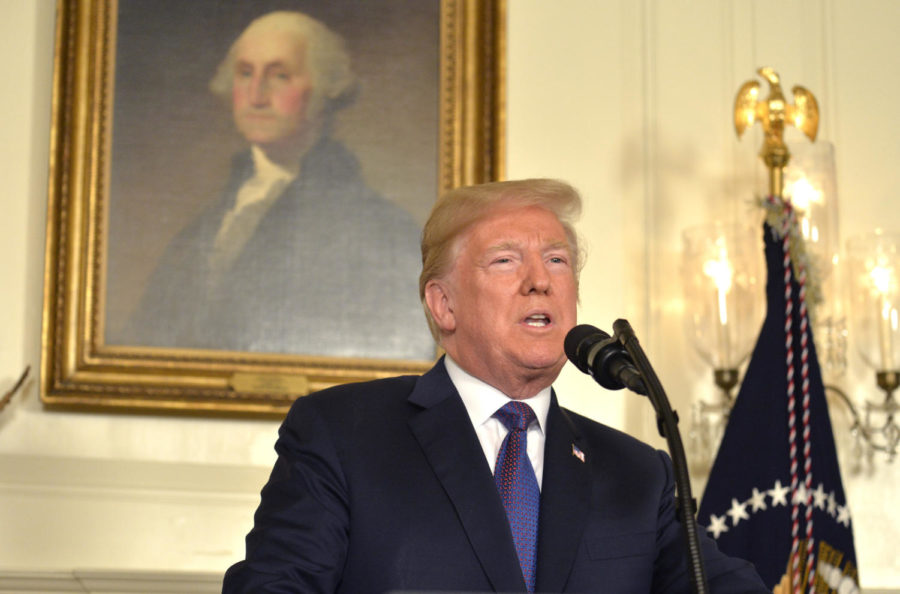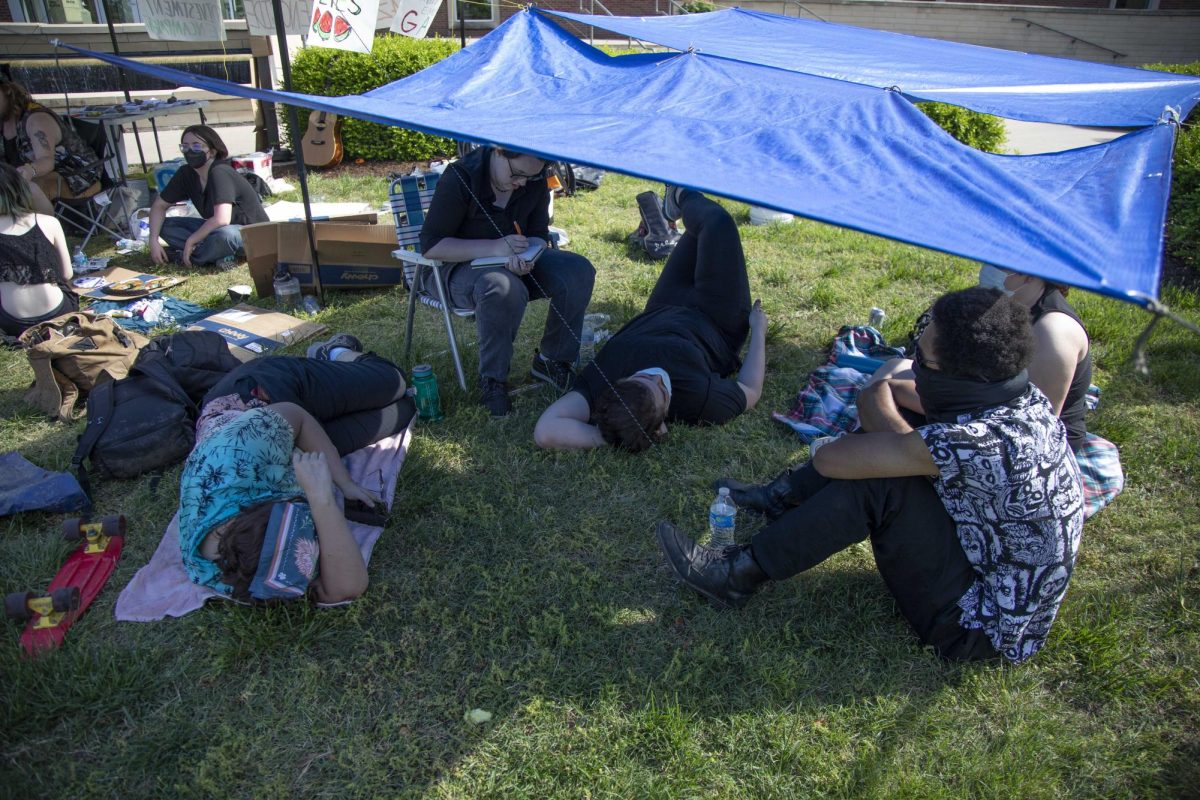US fires missiles at Syria in retaliation for suspected poison gas attack
President Donald Trump announces military action against Syria for the recent gas attack on civilians, at the White House in Washington, D.C., on Friday, April 13, 2018. (Mike Theiler/Sipa USA/TNS)
April 14, 2018
WASHINGTON – U.S. and allied warships and warplanes in the eastern Mediterranean launched a fiery barrage of missiles at multiple military targets in Syria to punish the Russian-backed government in Damascus for its alleged use of poison gas against civilians last weekend, President Donald Trump announced.
Trump authorized the punitive attack against President Bashar Assad’s government and sought to cripple its chemical and biological weapons facilities with what he called precision airstrikes.
French and British forces joined the attack, Trump said in a televised address Friday night.
Advertisement
The Pentagon said about 120 missiles targeted a scientific center near Damascus that was used for research, development and production of chemical and biological agents; a chemical weapons storage facility west of Homs; and a separate chemical agent storage site and command post near Homs.
Officials said no U.S., French or British casualties were reported. “We are prepared to sustain this response until the Syrian regime stops its use of prohibited chemical agents,” Trump said.
Loud explosions and air raid sirens were reported in the Syrian capital as he spoke at 9 p.m. in Washington.
It was before dawn Saturday in Damascus.
At a subsequent Pentagon news conference, Defense Secretary James N. Mattis said that no follow-up strikes were planned, calling the attack a “one-time shot” intended to deter Assad from using poison gas again.
“Right now we have no additional attacks planned,” he said.
He said Pentagon planners took precautions to try to avoid endangering civilians or any Russian troops in Syria.
Advertisement*
He said he could not guarantee that the attacks on poison gas stockpiles did not release toxic agents in the air. U.S., British and French warplanes apparently fired air-to-ground missiles from hundreds of miles offshore, out of range of Syria’s sophisticated air defense batteries.
That allowed a more ambitious attack, with a more aggressive target list, than last year’s U.S. strike with 59 Tomahawk missiles on a single Syrian airfield in response to a nerve gas attack.
“Clearly the Assad regime did not get the message last year,” Mattis said. “This time our allies and we have struck harder.”
Mattis acknowledged that the U.S. had not confirmed yet that Syria had used sarin or other deadly nerve agents in last Saturday’s attack on a rebel-held town, but said U.S. intelligence had confirmed use of chlorine gas.
“We’re very confident chlorine was used,” Mattis said. “We’re not ruling out sarin right now.”
The British Defense Ministry said in a statement that four Royal Air Force Tornado GR4 warplanes took part in the attack and fired Storm Shadow missiles at a Syrian military base 15 miles west of Homs, near the border of Lebanon.
“Very careful scientific analysis was applied to… maximize the destruction of the stockpiled chemicals and to minimize any risks of contamination to the surrounding area,” the statement said.
Trump promised that the United States would not maintain an indefinite presence in the war-torn region, saying that “no amount of American blood or treasure” can bring stability to the Middle East.
“It is a troubled place,” Trump said.
He called on Russia and Iran, which he said are the chief enablers of the Syrian government, to relinquish their support.
“What kind of a nation wants to be associated with the mass murder of innocent men women and children?” he said, accusing the two countries of “supporting, equipping, and financing the criminal Assad regime.”
The predawn air assault Saturday raised concerns of a direct confrontation with Russia, which has an extensive network of ground-to-air missiles in Syria, as well as hundreds of troops and warplanes, and threatened to shoot down any U.S. missiles or planes that it saw as a threat. U.S. officials have been deeply worried that the strikes could inadvertently kill Russian troops.
But Gen. Joseph Dunford, chairman of the Joint Chiefs, told reporters that the Pentagon had not given Moscow advance warning of the attack.
The Pentagon used a special communications channel with Moscow to make sure the air space where U.S. was launching missiles was clear, Dunford said.
In last year’s air strike, the U.S. gave Russia advance warning of the attack in time for Russia to move its troops and equipment out of danger.
The Pentagon’s Central Command, which oversees U.S. military operations in the Middle East, made heavy use of the so-called deconfliction line with Moscow in recent days to gain a better picture of where Russian forces are deployed in Syria and to reassure Moscow that any U.S. strike will target only Syrian military units, facilities and equipment involved in last Saturday’s attack.
Trump’s Twitter posts and comments this week gave Syria time to move aircraft and troops out of likely target areas, and the advance warning made it more likely its advanced air defense batteries could shoot down U.S. cruise missiles or warplanes, complicating the Pentagon’s task of preparing a response.
Syrian state media said government air defenses had successfully intercepted 13 missiles targeting the Kisweh area of Damascus and the Homs area.
There was no independent confirmation. Syrian casualties weren’t yet known.
Syrian government troops had evacuated airports and primary military air bases in government-held areas in anticipation of a U.S. air attack, and reportedly moved some Syrian warplanes to Russian-controlled airfields for protection.
Fact-finding teams from the Organization for the Prohibition of Chemical Weapons, an international watchdog agency based in The Hague, were expected to arrive in Douma on Saturday to collect evidence on the April 7 attack that left 43 people dead and wounded hundreds more. U.S. officials said Syrian helicopters dropped gas-filled barrel bombs in Douma, a suburb east of Damascus.
Photos and videos showed victims, including children, foaming at the mouth, choking and twitching in agony.
Local medics and rescue workers said some of the victims emitted an odor that suggested chlorine gas had been used.
Others showed symptoms, including constriction of the pupils and convulsions, that suggested an illegal nerve agent such as sarin was mixed in.
The rebel-held town fell to Syrian forces after last week’s bombardment, and Russian troops also have entered the area.
Thousands of rebels and civilian residents have been evacuated.
Trump had telegraphed the attack early Wednesday in a tweet that taunted Russia as well as Assad.
“Russia vows to shoot down any and all missiles fired at Syria. Get ready Russia, because they will be coming, nice and new and ‘smart!’ You shouldn’t be partners with a Gas Killing Animal who kills his people and enjoys it!” Trump wrote.
Trump’s tweet followed a mid-level Russian diplomat’s claim that Russian President Vladimir Putin had authorized shooting down any U.S. missiles aimed at Syria.
The Kremlin did not confirm the warning.
“Russia will execute the statement of its president related to any U.S. aggression against Syria, knocking down American missiles and striking at the sources of fire,” Alexander Zasypkin, Russia’s ambassador to Lebanon, told the Lebanese television channel Al-Manar.
Russia has disputed claims by the U.S. and its allies that Assad’s forces used lethal chemical agents against civilians in Douma.
The airstrikes come almost exactly a year after U.S. warships fired 59 Tomahawk cruise missiles at a Syrian air base that U.S. intelligence said was used to carry out a nerve gas attack that killed about 75 people in the town of Khan Sheikhoun.
In that attack, the Pentagon avoided hitting suspected chemical-agent storage facilities at the Shayrat air base, for fear of spreading a toxic cloud, targeting planes and hangars there instead.
The Pentagon also gave advance notice to Moscow to ensure any Russian personnel at the base could leave before the attack.
The airfield was back in operation soon after, and Assad’s government began using less-lethal chlorine gas against rebel positions. Before the latest U.S. attack, the Pentagon had raised concerns that it might not have legal justification for an assault because it hasn’t confirmed that Syrian forces used a banned nerve agent.
Use of any lethal chemical agent as a weapon, especially against civilians, is barred under international law, but unlike sarin, chlorine gas is not specifically prohibited by international treaty.
Forensic evidence from alleged victims of the Douma attack, including blood and urine samples, that the U.S. has received through intermediaries indicate the presence of chlorine gas, but evidence that a deadly nerve agent such as sarin also was used is less clear, two officials said on condition of anonymity to discuss internal assessments.
Russia has repeatedly denied that a poison gas attack occurred, saying that gruesome photographs of victims were fake.
On Friday, Russian Foreign Minister Sergei Lavrov went much further, telling a state-run news site that Moscow had “irrefutable evidence” that the gas attack was a “performance” staged by a foreign spy service.
He did not identify the country or show any proof for his claim. But Maj. Gen. Igor Konashenkov, a spokesman for the Russian Defense Ministry, blamed Britain, telling reporters that London had “direct involvement,” according to Russia’s state news agency.
Konashenkov also said a Syrian medic who claimed to work at Douma’s central hospital said the victims suffered from smoke inhalation, not chemical exposure.
He said a “rent-a-mob” had entered the hospital saying there was a chemical weapons attack and had begun washing one another in front of cameras.
The medic said he “had not seen a single patient with signs of poisoning with chemicals,” Konashenkov said.
The British Foreign Office dismissed Moscow’s charges as “the latest in a number of ludicrous allegations from Russia, who have also said that no attack ever happened.
This simply shows their desperation to pin the blame on anyone but their client: the Assad regime.” British relations with Moscow already are in a tailspin.
Prime Minister Theresa May’s government has accused the Kremlin of trying to murder a former Russian spy and his daughter in southern England with a military-grade nerve agent known as Novichok.
The two survived the March 4 poisoning, and Moscow has repeatedly denied responsibility. The finger-pointing continued during an emergency session of the United Nations Security Council on Friday.
(Los Angeles Times staff writer Alexandra Zavis and special correspondent Nabih Bulos in Beirut and Tracy Wilkinson of the Tribune Washington Bureau in Washington contributed to this report.)
© 2018 Los Angeles Times. Visit Los Angeles Times at www.latimes.com. Distributed by Tribune Content Agency, LLC.
Advertisement









